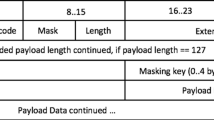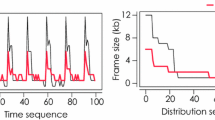Abstract
In this article, we present the design, implementation, and analysis of a scalable VOD (Video On Demand) distribution architecture for IP networks. The focus of our work is on the underlying multisource streaming architecture upon which the P2P (Peer-to-Peer) -based VOD services provisioning system relies. While multipoint-to-point multisource streaming is the core building block for a distributed VOD services provisioning system, it also introduces new reliability challenges as the streaming failure probability increases with the number of sources in a session. A major contribution of our work is the design of a suite of distinct yet complementary reliability/failover mechanisms that can be leveraged to improve the dependability of multisource streaming, and the viability of P2P-based VOD systems in general. Our work shows that the reliability/failover mechanisms can be arranged, combined, and alternated in advanced adaptation policies in order to deal with different conditions exhibited by the network. Another contribution of our work consists of implementing and assessing the performance of the different reliability mechanisms and adaptation policies in a real prototype system. We evaluate both the accuracy of streaming problems diagnosis, and the efficiency of the reliability mechanisms, in two adaptation strategies: one responsive to loss variation, and the other responsive to delay variation.



























Similar content being viewed by others
Notes
Note that the VidAs streaming system is fully compliant with the IETF standards for MPEG-4 Part 10 (resp., H.264) video fragmentation and streaming over IP networks [17]. It also complies with all ISMA (Internet Streaming Media Alliance) practices and recommendations for MPEG-4 video streaming over IP networks.
In the following, Stream Guardian and Content Guardian are sometimes interchangeably used. The multi-source streaming intelligence is indeed implemented in a distributed/hierarchical with the Content Guardian overseeing all active sub-streams and coordinating possible failover actions, while the Stream Guardian is responsible of monitoring sub-streaming QoS performance and enforcing failover actions.
References
Annapureddy S et al (2007) Exploring VoD in P2P swarming systems. In: Proc. of IEEE INFOCOM. Anchorage, Alaska, USA, pp 2571–2575
Apostolopoulos J et al (2002) On multiple description streaming with content delivery networks. In: Proc. of IEEE INFOCOM 2002, vol. 3. New York, NY, pp 1736–1745, June
Bindal R, Cao P (2006) Can self-organizing P2P file distribution provide QoS guarantees? In: ACM SIGOPS operating systems review, special issue on self-organizing systems, vol. 40, issue 3, pp 22–30, July
de Asis Lopez-Fuentes F, Steinbach E (2008) Adaptive multi-source video multicast. 2008 IEEE International Conference on Multimedia and Expo, IEEE ICME 2008. Hannover, Germany, pp 457–460, 23–26 April
Do TT et al (2004) P2VoD: providing fault tolerant video-on-demand streaming in peer-to-peer environment. In: Proceedings of 2004 IEEE International Conference on Communications, vol. 3. Paris, France, pp 1467–1472, 20–24 June
Dongyan X, Hefeeda M, Hambrusch S, Bhargava B (2002) On peer-to-peer media streaming. In: Proc. of the 22nd IEEE International Conference on Distributed Computing Systems 2002, IEEE ICDCS’02. Vienna, Austria, pp 363–371, 2–5 July
Hefeeda M et al (2003) PROMISE: peer-to-peer media streaming using collectcast. In: Proceedings of ACM MULTIMEDIA 2003. Berkley, CA, USA, pp 45–54, 2–8 November
Huang Y et al (2007) When is P2P technology beneficial to IPTV services? NOSSDAV 2007, Urbana-Champaign, IL, USA, June
Huntington D (2005) U.S. Patent num. 6,970,937 (Filed on Jun 15, 2001): user-relayed data broadcasting. Abacast Inc., November 29th
Itaya S, Enokido T, Takizawa M, Yamada A (2005) A scalable multimedia streaming model based-on multi-source streaming concept. In: Proc. of 11th IEEE International Conference on Parallel and Distributed Systems, IEEE ICPADS 2005, vol. 1. Fuduoka, Japan, pp 15–21, 20–22 July
Liao X et al (2006) AnySee: peer-to-peer live streaming. In: Proceedings of IEEE INFOCOM 2006. Barcelona, Spain, pp 1–10, April
Magharei N, Rejaie R (2007) PRIME: peer-to-peer receiver-driven mesh-based streaming. In: Proc of 26TH IEEE INFOCOM 2007. Anchorage, AL, USA, pp 1415–14236, 7–12 May
Mundur P et al (2004) End-to-end analysis of distributed video-on-demand systems. In: IEEE Transactions on Multimedia, vol. 6, no. 1, February
Nafaa A (2010) Design, implementation, and analysis of a scalable VOD services delivery system: a P2P architecture. In: IEEE Transactions on Parallel and Distributed Systems, to appear in June
Schierl T, Ganger K, Hellge C, Wiegand T, Stockhammer T (2006) SVC-based multisource streaming for robust video transmission in mobile ad hoc networks. In: IEEE Wireless Communications Magazine, vol. 13, issue: 5, pp 96–103, October
Vikash A, Reza R (2005) Adaptive multi-source streaming in heterogeneous peer-to-peer network. In: Proc. of the SPIE Multimedia Computing and Networking Conference 2005, vol. 5680. San Jose, CA, USA, pp 13–25, 19–20 January
Yoshihiro K et al (2000) RFC3016: RTP payload format for MPEG-4 Audio/Visual streams. Internet Engineering Task Force, November
Author information
Authors and Affiliations
Corresponding author
Additional information
This material is partially based upon works supported by the Science Foundation Ireland under Grant No 09/SIRG/I1560. The work was also partially supported by the Enterprise Ireland VidAs project, Technology Development Commercialisation Fund, CFTD/07/203—VIDAS.
Rights and permissions
About this article
Cite this article
Nafaa, A., Gourdin, B. & Murphy, L. A dependable multisource streaming system for peer-to-peer -based video on demand services provisioning. Multimed Tools Appl 59, 169–220 (2012). https://doi.org/10.1007/s11042-011-0755-8
Published:
Issue Date:
DOI: https://doi.org/10.1007/s11042-011-0755-8







